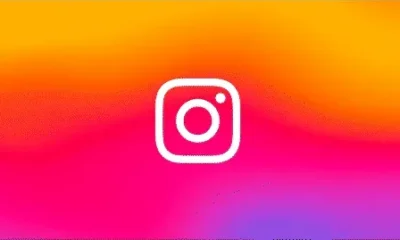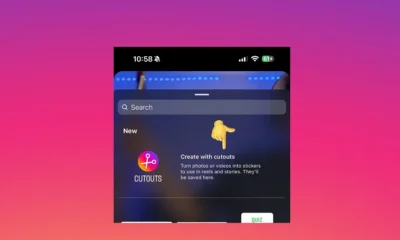MARKETING
10 Inspiring Instagram Contests That Caught Our Attention

Instagram is huge.
It has more than 1 billion users and is the third most popular social media site today.
But Instagram isn’t all about pretty photos and clever art.
In fact, it’s becoming a huge marketing platform where Fortune 500 companies are stepping into the scene.
With all these big companies vying for the attention of users, how can you put your brand forward in the feed so it receives acclaim and attention on Instagram?
The answer is through running an Instagram contest.
Why Run an Instagram Contest?
There are many ways you can advertise on Instagram. You can buy ads. Write copy. Post photos of products.
But nothing comes close to running an Instagram contest.
Why? Because of user engagement.
When you run an Instagram contest, you make a way for users to engage with your brand. They take photos with your product, tag friends, and spread the word about your company.
What’s the best way to run an Instagram contest?
10 Inspiring Brands That Did Instagram Contests Right
Instead of coming up with a generic how-to, let’s look into 10 successful Instagram contest campaigns.
Ready to be inspired?
1. Love One Today’s Avocado Contest
Love One Today promotes a delicious way of life through eating avocados.
To gain buzz online, it launched the AvoFruitFull contest.
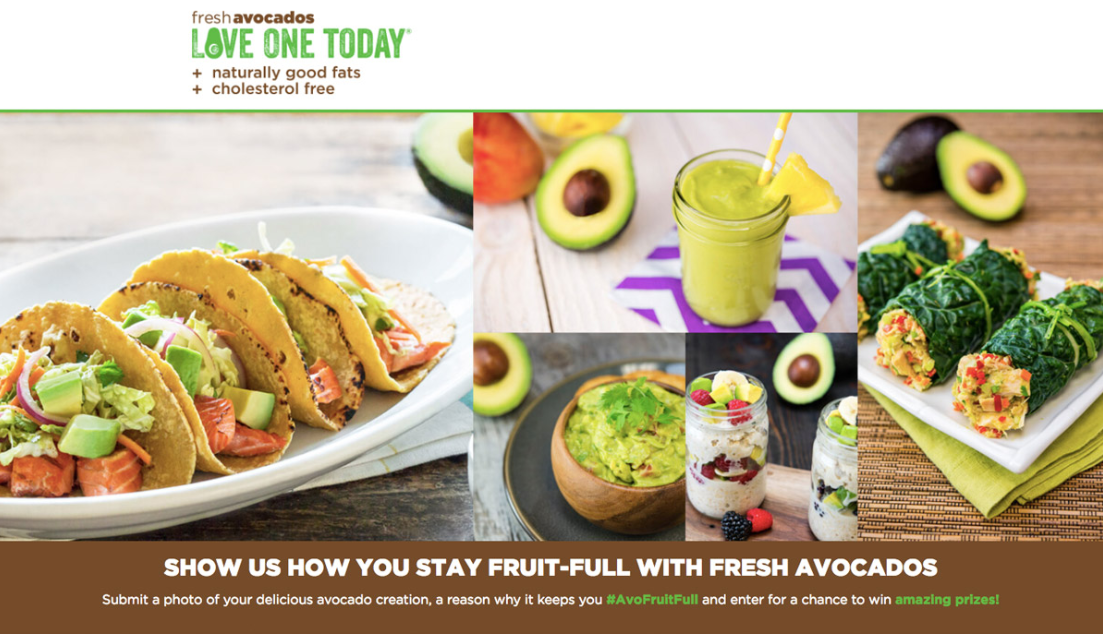
Instagram users were encouraged to submit a photo of their own beautiful avocado creations.
Users who got the most likes on their photos won great prizes such as themed water bottles, a food processor, and even a Vitamix blender!
Tip: Offering giveaways that resonate with your followers’ interests (like a Vitamix blender for health-conscious people) is a great way to get your contest going.
2. Stoka Bar’s Boatload of Giveaways
Who wouldn’t grab the chance to win 40 free treat bars?
Stoka Bars are crunchy, delicious, and best of all – low on carbs.
Here’s the contest Stoka Bar did to gain more followers.
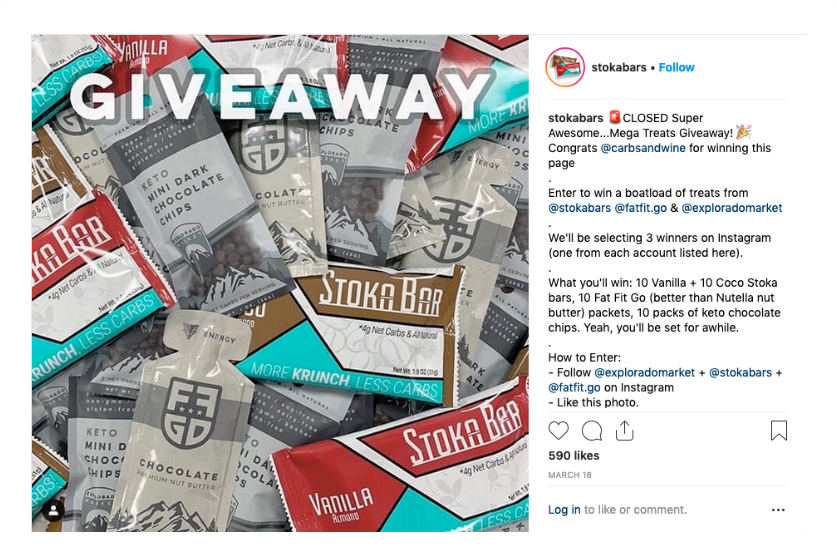
Tip: If your Instagram page is new, a contest is a great way to gain new followers.
3. Pink Lime Look’s Good Hair Day Contest
Pink Lime Look gave contestants the chance to be themselves in their entries.
To join the contest, users submitted photos of themselves sporting their favorite hairstyles.
They could choose whatever background they liked for the entry.

All contestants had to do was use Pink Lime Look’s hashtag for the chance to win.
Pretty simple, considering the prize was a $500 makeover!
Tip: If you’re giving out a valuable prize, make sure to mention how much it’s worth for the chance to grab more attention.
4. Lifebox Food and Punks and Chancers Collab Contest
Organic materials and ingredients are essential to anyone who’s health-conscious or vegan.
Take a look at how Lifebox Food and Punks and Chancers ran their collaboration contest on Instagram.
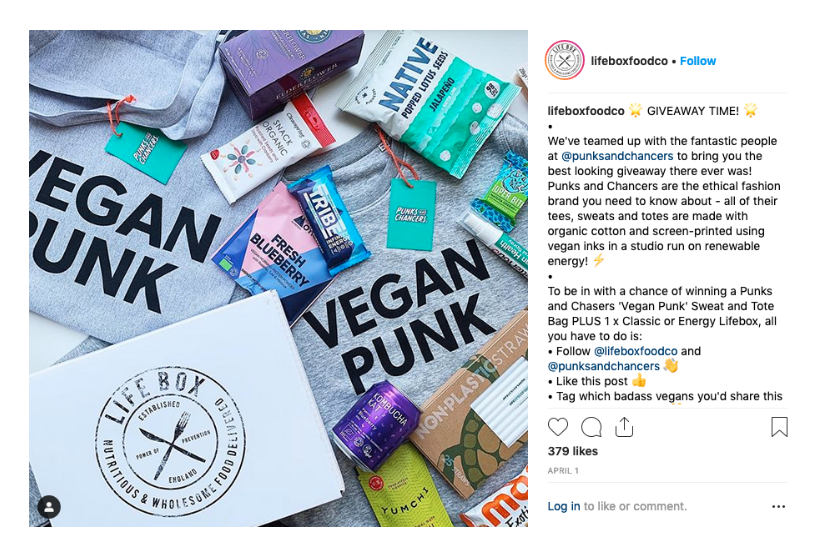
All users had to do was follow the two companies, like the post, and tag a friend.
The prize?
A cool sweater, a tote bag, and a delicious box of vegan food.
Tip: Collaborating with another company for your Instagram contest is an effective way to gain more followers. It’s great if the company you collaborate with already has its own strong base of followers.
5. How to Make Trouble by Simon and Schuster
Unique contests that ask users for stories almost always steal the show on Instagram.
Here’s the perfect example of how it’s done.

The contest encouraged users to comment with their own personal “troublemaking” strategies.
The prize?
Cecile Richard’s new book, a tote bag, cute pins, and a bookmark.
That’s a lot in exchange of a story!
Tip: One of the reasons people are on Instagram is because they love to share their lives with others. If you ask for their stories in exchange of cool prizes? You’ll have a sure hit.
6. Valdo Prosecco’s Trip to Italy
Who wouldn’t want to win a spectacular trip to one of the most beautiful countries in the world?
With its contest, Valdo Prosecco made the trip an enticing prize.

All users had to do was take a photo of a cocktail they’d made with Valdo Prosecco.
They then shared their secret recipe as a caption with a hashtag.
The winner was picked out of the 25 top-voted photos.
Tip: Whenever you can, encourage contestants to be creative. Also, letting users vote for top photos is a great way to promote engagement with your brand.
7. Melissa Corser’s Makeup Giveaway
Makeup and nails are the perfect combination for girls who love to get glamorous.
Melissa Corser gave Instagram users the chance to win both with her contest.

What made this contest different was that users could enter as many times as they wanted.
The result?
More tagged friends, engagement, and exposure.
Tip: Who says contestants can only enter a contest once? When you give them unlimited entries, you get massive engagement in return.
8. Fushi’s New Product Launch
When Fushi launched its Biovedic skincare solution, it took to Instagram with a contest.
The prize?
A full set of Ayurvedic skin products for healthier, more beautiful skin.

Tip: If you’re launching a new product, running an Instagram contest and giving the product away as a prize is a huge way to promote it.
9. Shockingly Healthy’s Contest for Free Tickets
For those into the healthy lifestyle, there are few things as exciting as a Green Living Show.
What Shockingly Healthy did was capitalize on that interest with two sets of free tickets for the show.

Tip: Are there any events in your area that would interest your followers? If so, offering free passes or tickets as prizes is a great way to increase engagement with your brand.
10. Domino’s Super Fan Contest
Domino’s contest offered a huge prize to users who could prove they were “super fans” of its pizza.

The prize? $10,000!
To add to the fun, the contest allowed users to be creative.
They had to prove they weren’t only fans, but super fans of Domino’s.
Tip: The more creative your contest is, the better! If you can give a big cash prize, it won’t hurt your chances of getting thousands of engagements, either.
How to Create an Instagram Contest That Goes Viral
Instagram is huge, and it opens the door to massive marketing opportunities for you.
Also, running an Instagram contest promises you user engagement, attention, and interest.
All you need to do is find out what works and how to set up your Instagram contest.
Remember, allow users to be creative and tell their stories.
Keep in mind why people use Instagram at all: to take stunning photos, be spontaneous, and share their lives with others.
There’s a ton of prize ideas you can select as giveaways. These can be cash, new products, unique knick-knacks, and anything related to your business.
When you’ve set up a contest that follows these cool tips, all you need to do is sit back and wait for the follows and shares to start pouring in!
Image Credits
All screenshots taken by author, November 2019







